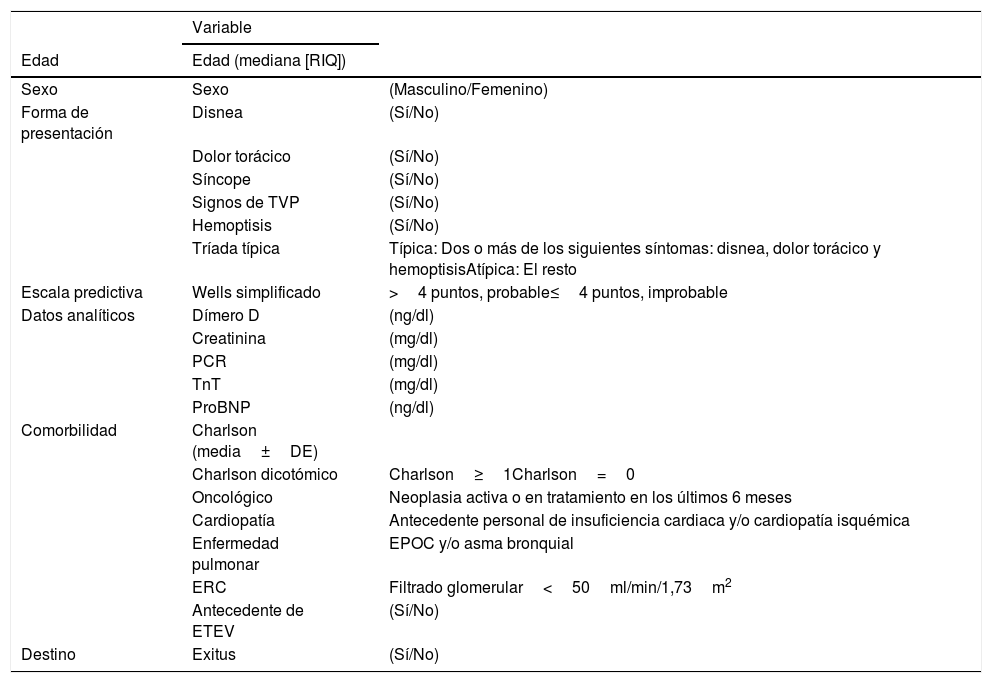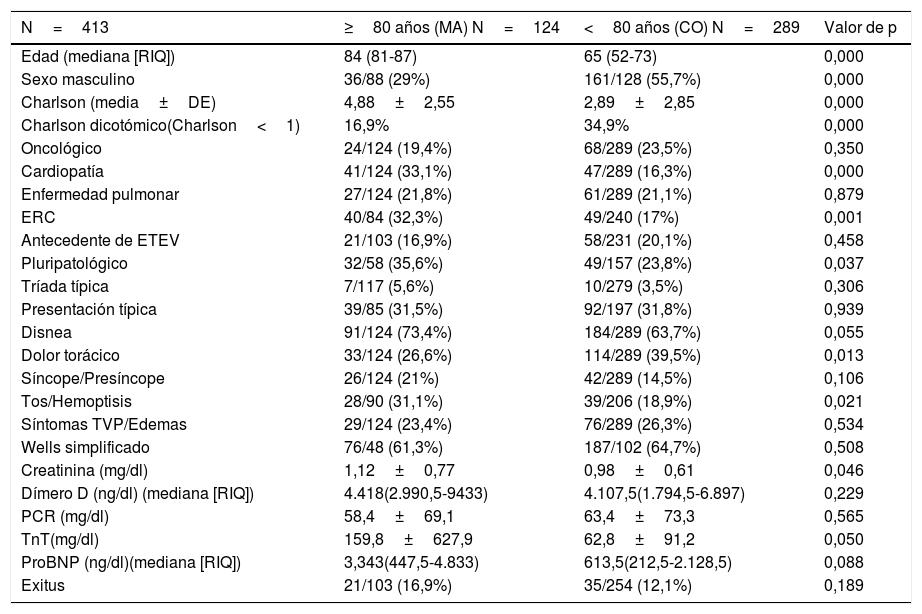El diagnóstico de embolia pulmonar supone un reto. Su presentación comparte manifestaciones clínicas con otras entidades. En los pacientes muy ancianos (MA≥80 años) el reto aumenta por la comorbilidad asociada comparando con controles más jóvenes (CO<80 años).
ObjetivoDescribir la incidencia de embolia pulmonar en pacientes muy ancianos en nuestro medio, identificar diferencias en manifestaciones clínicas, comorbilidad y parámetros analíticos entre subgrupos (MA/CO).
MétodoEstudio casos-controles de base hospitalaria. Revisión de las embolias pulmonares diagnosticadas, en nuestro centro, mediante angiografía pulmonar por tomografía computarizada entre 2013 y 2016.
ResultadosIncluimos 413 pacientes (124 MA). La edad mediana fue 72 años [RIQ 58-81]. La tríada típica de presentación fue poco frecuente y no mostró diferencias entre subgrupos. Los principales síntomas de presentación fueron: disnea (73,4% MA vs. 63,7% CO; p=0,055), dolor torácico (26,6% vs. 39,5%; p=0,013) y tos/hemoptisis (31,1% vs. 18,9%; p=0,021). Presentaron mayor comorbilidad los MA (4,88±2,55 vs. 2,89±2,85; p=0,0001).
ConclusiónUn 30% de las embolias pulmonares fueron en MA. La forma de presentación típica fue infrecuente. Se detectaron diferencias significativas en síntomas individuales, comorbilidad y parámetros de laboratorio en comparación con pacientes más jóvenes.
Diagnosing pulmonary embolisms can be challenging, given that its presentation shares clinical manifestations with other conditions. For patients 80 years of age or older, the healthcare challenge increases due to associated comorbidity when compared with younger patients (<80 years).
ObjectiveThe aim of our study was to report the incidence of pulmonary embolism in elderly patients in our setting and identify differences in the clinical manifestations, comorbidity and laboratory parameters between these 2 groups of patients.
MethodWe conducted a hospital-based, case-control study to review the pulmonary embolisms diagnosed in our centre using computed tomography pulmonary angiography between 2013 and 2016.
ResultsThe study included 413 patients, 124 of whom were 80 years of age or older, with a median age of 72 years (IQR, 58-81). The typical presentation triad was uncommon and showed no differences between subgroups. The main symptoms presented by these groups were dyspnoea (73.4% vs. 63.7% for the elderly and younger groups, respectively; P=.055), chest pain (26.6% vs. 39.5%; P=.013) and cough/haemoptysis (31.1% vs. 18.9%; P=.021). The elderly group had more comorbidity (4.88±2.55 vs. 2.89±2.85; P=.0001).
ConclusionThirty percent of the pulmonary embolisms occurred in the elderly group. The typical presentation form was uncommon. We detected significant differences in individual symptoms, comorbidity and laboratory parameters compared with the younger patients.
Artículo
Diríjase desde aquí a la web de la >>>FESEMI<<< e inicie sesión mediante el formulario que se encuentra en la barra superior, pulsando sobre el candado.

Una vez autentificado, en la misma web de FESEMI, en el menú superior, elija la opción deseada.

>>>FESEMI<<<









